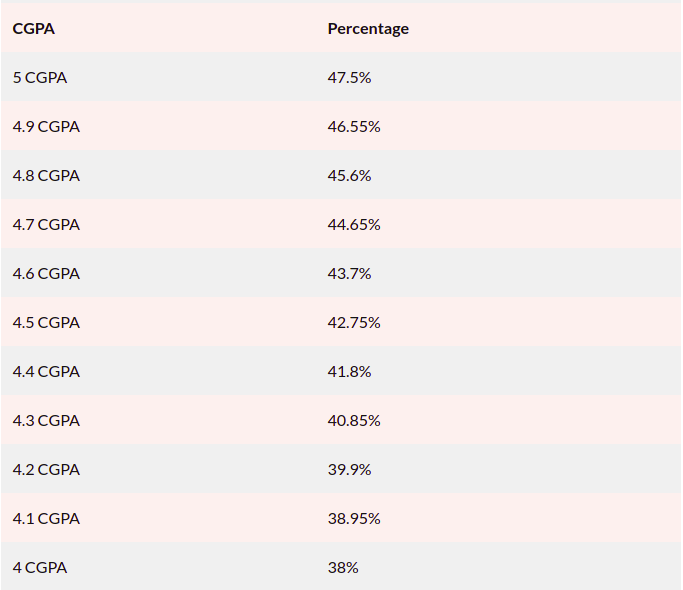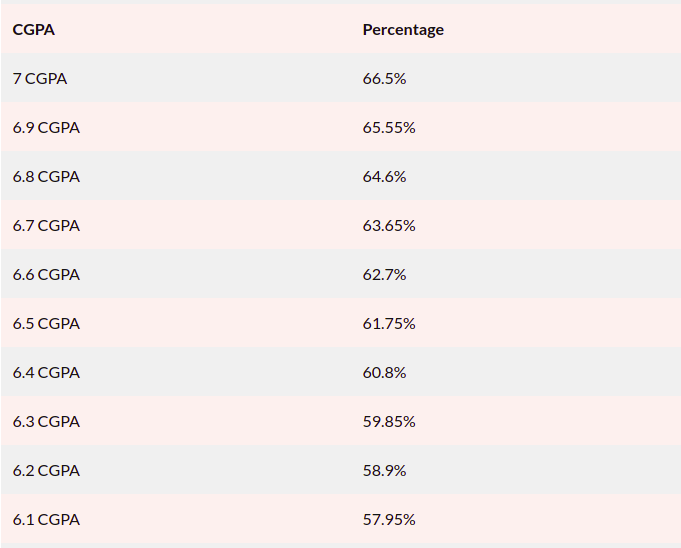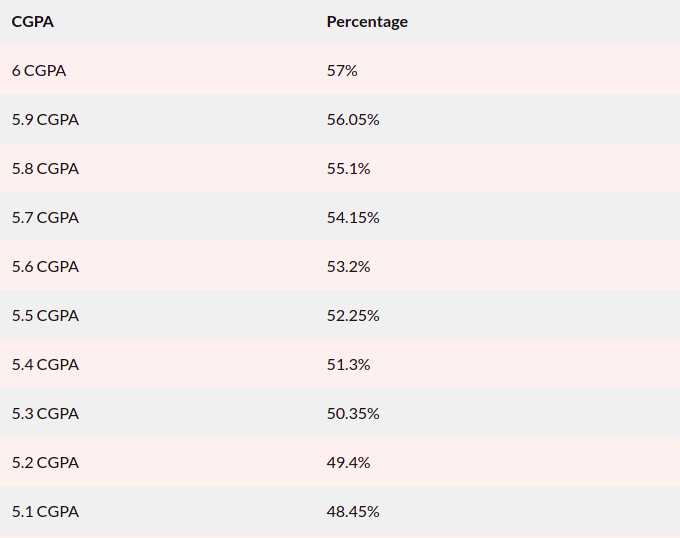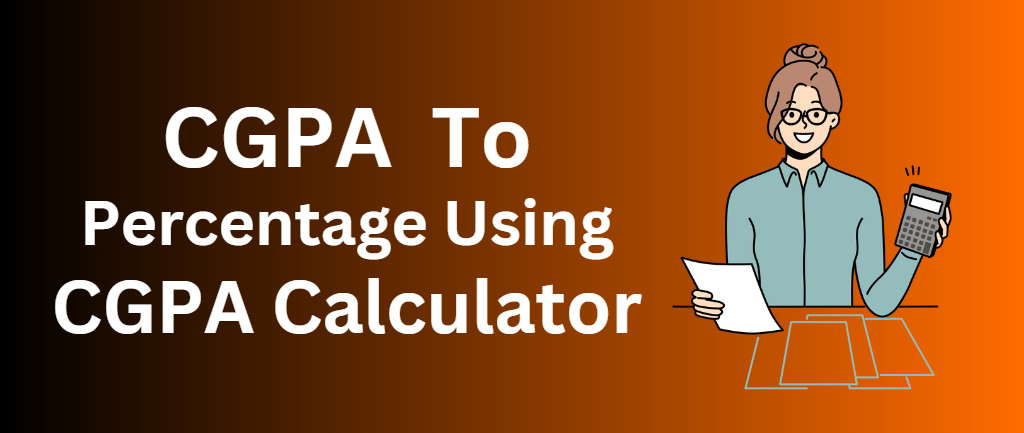Table of Contents
What is CGPA exactly?
The Cumulative Grade Point Average (CGPA) is a measure of a student’s academic performance in a specific academic program or course. It is calculated by averaging the grade points from all the courses or subjects a student has taken over a semester or academic year.
Each grade a student receives is assigned a grade point value, usually ranging from 0 to 4 or 0 to 10, depending on the grading system of the academic institution. For instance, an “A” grade might be given a grade point of 4, while a “B” grade might be assigned a grade point of 3. The CGPA is then calculated by adding the grade points from all courses and dividing by the total number of courses taken.
CGPA is widely used in many educational systems globally, especially in higher education institutions. It serves as a measure of a student’s academic performance and is often used to determine academic standing, eligibility for scholarships, and other forms of recognition.
How to Compute CGPA from GPs?
To calculate CGPA from subject grade points (GPs), you add the GPs of your main subjects and divide the total by the number of those subjects. For example, if your grades are as follows: 7 in Math, 10 in English, 9 in French, 10 in Science, and 8 in Social Studies, you would calculate your CGPA like this:
1. Add the grade points: \(7 + 10 + 9 + 10 + 8 = 44\).
2. Divide the total by the number of subjects: \(44 / 5 = 8.8\).
So, your CGPA would be 8.8.
Grading system
The grading system used to assign grade points differs per institution.
Most universities in India use a 10-point grading system. The followings are the grade points and their related grades:
| Sr.No. | Grade Point | Grade |
|---|---|---|
| 1 | 10 | A+ |
| 2 | 9 | A |
| 3 | 8 | B+ |
| 4 | 7 | B |
| 5 | 6 | C+ |
| 6 | 5 | C |
| 7 | 0 | F (Fail) |
How to Calculate/Convert CGPA into percentage?
To convert CGPA into a percentage, multiply the CGPA by a conversion factor. The conversion factor varies according to the educational institution and grading system. However, the most typical conversion factor is 9.5 for a 10-point CGPA scale and 5 for a 4-point CGPA scale. Here’s how to use the 9.5 conversion factor to convert CGPA to percentage:
First, divide the CGPA by 9.5.
The resultant figure is the CGPA’s percentage equivalent.
For example, if a student has a CGPA of 8.5 on a scale of 10, the percentage equivalent is:
8.5 x 9.5 = 80.75%
As a result, the student’s CGPA equivalent in percentage is 80.75%.




Why Convert CGPA to Percentage?
Both CGPA and percentage are measures of academic success, but they are expressed differently. CGPA is a weighted average of a student’s grade points earned in all courses completed during a specified period. In contrast, the percentage represents the marks a student earned in a specific course or test.
While CGPA is widely used in many educational institutions, some employers or higher education institutions prefer academic success reported in percentage terms. This preference is because the percentage is a more familiar and straightforward measure of academic achievement, commonly used worldwide.
Converting CGPA to a percentage allows for the comparison of academic achievement across different educational systems and grading scales. This conversion provides a standardized method of describing academic performance, which is valuable for admission to higher education institutions or employment applications that require a standardized assessment of academic success.
Moreover, there may be minimum percentage criteria for admission to further education institutions or job opportunities in some cases, and converting CGPA to a percentage can help determine if a student meets those requirements.
CGPA to Percentage Conversion
For students who need to present their academic achievement in percentage terms, converting CGPA to percentage is essential. The CGPA grading method is used by CBSE, VTU, GTU, Anna University, Mumbai University, and many other Indian universities. CBSE students use a 10.0 CGPA scale, while other universities’ scales range from 4.0 to 10.0. You can use a CGPA-to-percentage converter to convert your CGPA to a percentage. This calculator is readily available online and provides accurate results.
CBSE CGPA to Percentage Calculator
The Central Board of Secondary Education (CBSE) is India’s leading educational authority. Students who have completed their class 10 or 12 examinations will find the CBSE CGPA to Percentage calculator helpful. The CBSE uses a 10.0 CGPA scale, and the CBSE CGPA to Percentage calculator translates the student’s CGPA to a percentage based on this scale.
GTU CGPA to Percentage Calculator
Gujarat Technological University has developed a detailed conversion standard for calculating one’s percentage from CGPA/CPI/SPI. GTU students can convert their CGPA to a percentage by using the formula:
Percentage = (CGPA/SPI/CPI – 0.5) * 10
VTU CGPA to Percentage Calculator
Visvesvaraya Technological University (VTU) students can follow this formula to calculate their percentage by using the CGPA:
Percentage = [CGPA – 0.75] * 10
Delhi University (DU) CGPA to Percentage Calculator
The official announcement for Delhi University’s consistent technique of converting CGPA to % was announced on January 11, 2018. Here is the algorithm for calculating % from CGPA for DU students:
Final Percentage = 9.5 x Semester CGPA
Mumbai University (MU) CGPA to Percentage Calculator
Mumbai University’s conversion mechanism for CGPA to Percentage was recently revised in 2018 and now specifies multiple-point scales for different programs. MU has made the following key recommendations:
- A 7-point scale is utilised for programs in Pure Sciences, Arts, Commerce, and associated subjects. It calculates the student’s “actual marks” as a percentage.
- For Engineering, the CGPA to Percentage conversion is accomplished using the 10 Point Grading System, which is as follows:
Percentage = 7.25 * CGPA +11
Mumbai University (MU) CGPA to Percentage Calculator
Mumbai University”s conversion mechanism for CGPA to Percentage was recently revised in 2018 and now specifies multiple-point scales for different programs. MU has made the following key recommendations:
- A 7-point scale is utilised for programs in Pure Sciences, Arts, Commerce, and associated subjects. It calculates the student’s “actual marks” as a percentage.
- For Engineering, the CGPA to Percentage conversion is accomplished using the 10 Point Grading System, which is as follows: Percentage = 7.25 * CGPA +11
KTU CGPA to Percentage Calculator
KTU’s calculation technique is likewise relatively simple since it specifies a specific formula for calculating CGPA and then converts it to a percentage.
For example: CGPA = (Ci*GPi)/(Ci)
- Ci = Credit granted to a certain course
- GPi = Grade Point Average for the Course
Then after, you can simply calculate the percentage by multiplying CGPA with 9.5
MAKAUT CGPA to Percentage Calculator
MAKAUT (Maulana Abul Kalam Azad University of Technology) uses a 7-point grading system. The conversion technique is quite similar to VTU, i.e.
Percentage = [CGPA-0.75]* 10
How to Convert Percentage to CGPA?
To convert a percentage to CGPA, divide the percentage by the conversion factor. The educational institution and grading system varies according to the educational institution. The conversion factor is 9.5 for a 10-point CGPA scale and 5 for a 4-point CGPA scale.
For example, if a student receives an 85% on a test and wishes to translate it to a 10-point CGPA scale, the CGPA equivalent is:
100 / 9.5 = 8.94.
As a result, the student’s CGPA equivalent of 85% is 8.94 on a scale of 10.
It’s crucial to remember that various educational institutions may employ different conversion factors; thus, verify with your university or refer to their official conversion rules for appropriate conversion.
What are the benefits of using CGPA?
The CGPA (Cumulative Grade Point Average) is a metric used by educational institutions to assess a student’s overall academic achievement. Here are some advantages of using CGPA:
1. Clear Representation: CGPA provides a single figure that summarizes a student’s overall academic performance, making it easy for employers, graduate schools, and other institutions to understand.
2. Objective Measure: Since CGPA is based on a standardized grading system, it offers an objective measure of academic success, removing subjectivity from performance evaluations.
3. Motivates Students: The CGPA encourages students to maintain high academic standards throughout their studies.
4. Simplifies Comparisons: CGPA provides a standardized measure of academic success, making it easier to compare performance across different institutions and programs.
5. Informed Decision-Making: Students can use their CGPA to make informed decisions about their academic and career goals. For example, a high CGPA may improve chances of getting accepted into competitive graduate programs or securing jobs in competitive fields.
What are the benefits of using CGPA?
Clear and Concise Representation: CGPA provides a single figure that summarizes a student’s overall academic performance, making it easy for employers, graduate schools, and other institutions to understand.
Objective Measure: CGPA offers an objective assessment of academic success, as it is based on a standardized grading system that removes subjectivity.
Motivates Students: The CGPA encourages students to maintain high academic standards throughout their studies.
Simplifies Comparisons: CGPA provides a standardized measure of academic performance, making it straightforward to compare achievements across different institutions and programs.
Aids Decision-Making: Students can use their CGPA to make informed decisions about their academic and career goals. For example, a high CGPA can enhance chances of acceptance into competitive graduate programs or securing jobs in competitive fields.
What are the disadvantages of using CGPA?
CGPA provides a single figure that reflects a student’s overall academic achievement but lacks detailed information about performance in individual courses or specific areas of study.
Inadequate Depiction of Skills: CGPA focuses solely on academic performance and may not fully reflect a student’s abilities or potential. Extracurricular activities, professional experience, and personal attributes also contribute to a student’s success.
Lack of Standardization: CGPA calculation methods can vary between institutions, making it difficult to compare academic achievements across different schools and programs.
Subjectivity in Grading: Despite the standardized grading system, subjective elements in the grading process can affect the accuracy of the CGPA.
Overemphasis on Grades: A high CGPA can create a high-pressure environment where grades are prioritized over learning and personal growth.
Overall, while CGPA is useful for assessing academic success, it should be considered alongside other indicators when evaluating a student’s talents and potential.
In Demand Online Courses Specialization
Cumulative Grade Point Average, abbreviated as CGPA, is commonly used to assess a student's overall academic performance in a particular program. CGPA is calculated by averaging the grade points earned in each semester and then dividing by the total number of credits. In the CGPA system, a Grade Point of 9 typically corresponds to a range of 90-95 percentage points. Many academic institutions provide online CGPA conversion tables to help students convert their CGPA to percentage scores.
At Mumbai University, CGPA is transformed into percentage using the equation: Percentage (%) = 7.1 * CGPA + 11 (CGPA is converted to the percentage at Mumbai University). If you have a CGPA of 6.2, you can convert it to a percentage by multiplying it by 7.1 * 6.2 + 11 to get 55.02 per cent.
Percentage= (CGPA-0.75)*10
Percentage (%) = CGPA*10
Percentage= CGPA X 9.5
The CBCS allows students to choose from a list of specified courses that includes core, elective/minor, and skill-based courses. Students' performance in courses can be rated using the grading technique, which is better than the traditional mark system.
The 10 Point Grading System (CBCS) percentage is calculated as follows: Percentage. (%) = 7.1 * CGPA +11. The percentage can be calculated using the above method and rounded to the nearest complete integer.
The semester grade point average (SGPA) measures a student's overall performance over a semester. A student's semester grade point average (SGPA) is the weighted average of the grade points achieved in all courses taken during the semester.

